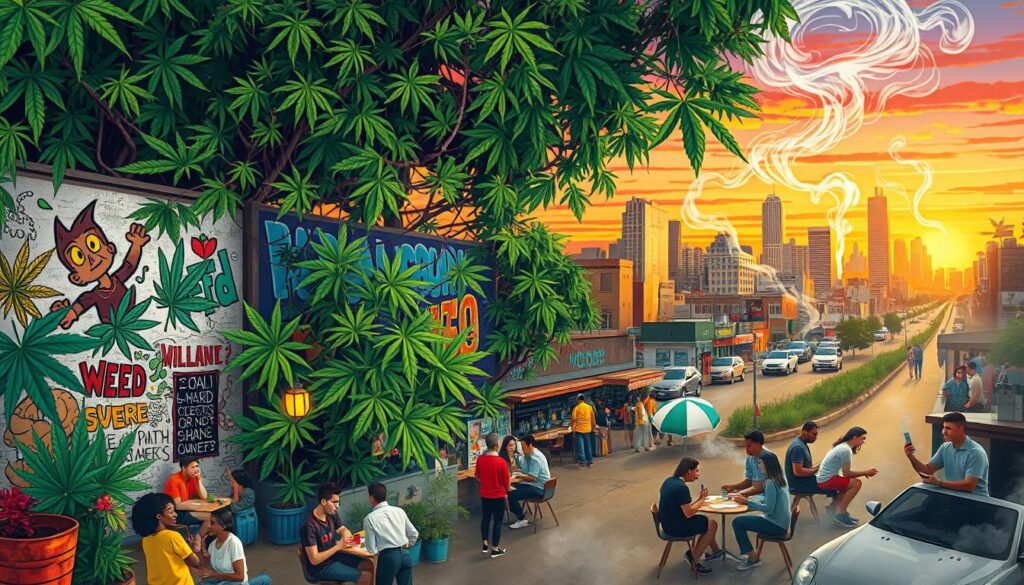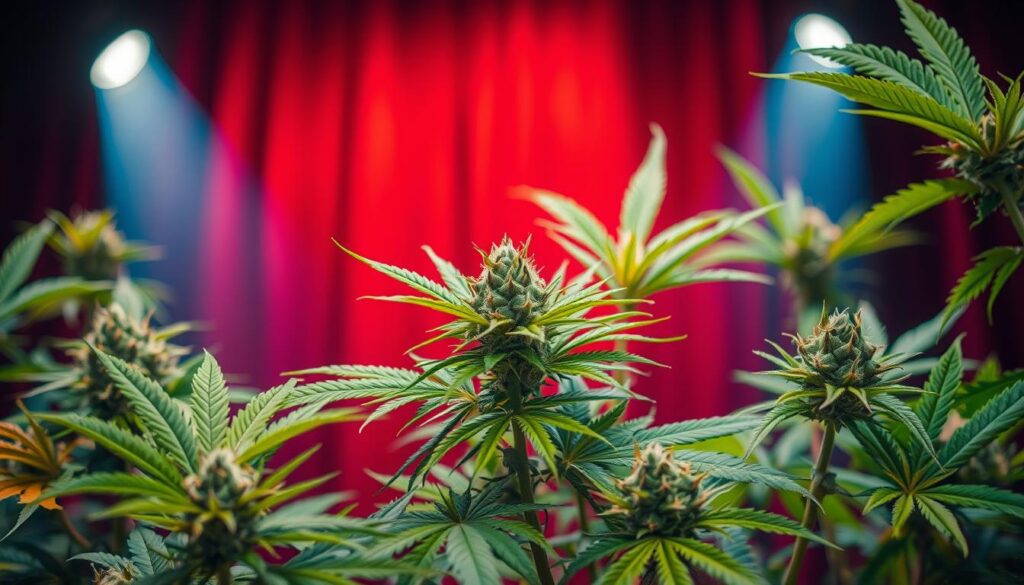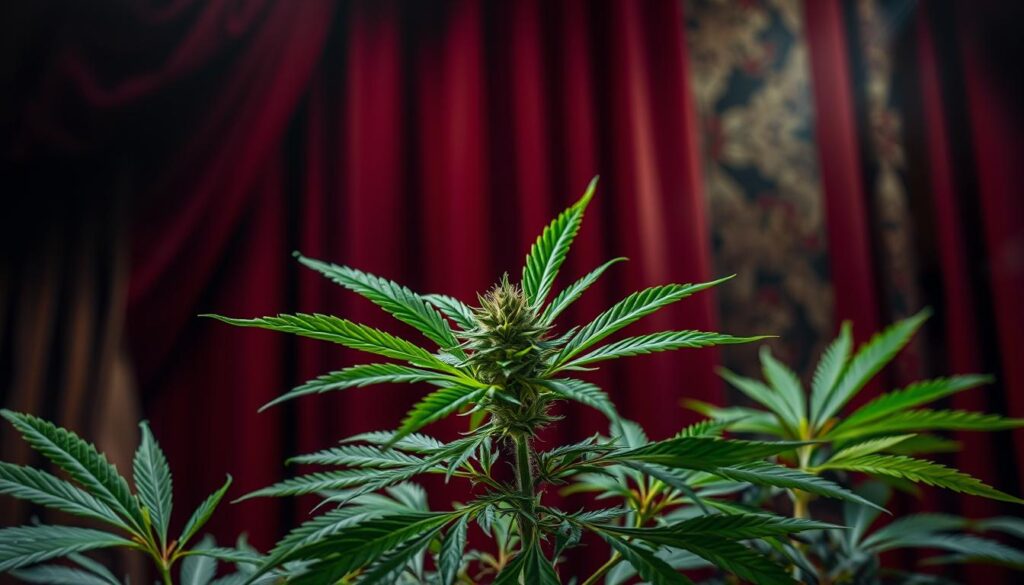Weed, cannabis, marijuana, or whatever you call it, has long been a part of the dramatic landscape. From Shakespeare’s enigmatic references to modern playwrights’ bold portrayals, the herb has woven its way into the tapestry of theatrical storytelling. In this captivating exploration, we’ll dive into the complex and multifaceted role of weed in dramatic narratives.
We’ll unravel how its representation has evolved over time. This evolution has influenced character development, societal commentary, and the very essence of the stage.
Key Takeaways
- Discover the rich history of weed in dramatic narratives, from classic theater to modern plays.
- Explore how the portrayal of cannabis has evolved, reflecting cultural shifts and societal attitudes.
- Delve into the impact of weed on character development, storytelling, and societal commentary in the world of drama.
- Examine the complex relationship between weed and counterculture, as depicted on stage.
- Understand the role of weed in comedic dramas and the lighthearted perspectives they offer.
The Role of Weed in Dramatic Narratives
Weed has been a big part of stories for a long time. From old plays to new ones, it helps tell stories. It shows us about different cultures, talks about big issues, and helps us get to know characters better.
From Shakespeare to Modern Plays
Shakespeare’s famous plays like “Hamlet” and “Macbeth” mention weed. It shows the characters’ deep thoughts and feelings. Today, weed in plays is used to question rules and talk about freedom.
Weed as a Symbol of Counterculture
Weed is now a sign of standing up against the rules. It helps tell stories of people who are not heard. It talks about fairness, who we are, and wanting to be free.
| Play | Portrayal of Weed | Themes Explored |
|---|---|---|
| “Angels in America” by Tony Kushner | Weed is used as a means of coping with the AIDS crisis and societal oppression | Social justice, LGBTQ+ rights, and the power of personal transformation |
| “The Pot” by Kia Corthron | Weed is a central element in the character’s journey of self-discovery and rebellion | Counterculture, personal identity, and the pursuit of freedom |
| “Weed” by Dennis Kelly | Weed is used as a means of escapism and a catalyst for societal commentary | Substance abuse, mental health, and the complexities of modern life |
Weed has been a big part of stories for a long time. It shows us about different cultures, talks about big issues, and helps us get to know characters better. It keeps making us think about our world.
Exploring the Portrayal of Weed in Drama
Step into the world of drama and see how weed, cannabis, marijuana, pot, ganja, mary jane, herb, bud, chronic, and dope are shown. Dramas from old to new show how views on these substances change. This change shows how society and culture evolve.
See how weed affects characters and stories. It can change what characters do and feel. It also shows us how society sees these substances.
“The play’s the thing wherein I’ll catch the conscience of the king.”
– William Shakespeare, “Hamlet”
Shakespeare’s works, like “Hamlet,” often include marijuana. His use of these substances has shaped our views on them in stories.
The 1960s counterculture and today’s debates on legalization are reflected in drama. These stories show how pot, ganja, and mary jane reflect our changing world. They help us understand our culture better.
Exploring drama, you’ll find surprises and new insights. The stories of herb, bud, chronic, and dope are complex. They deeply affect how we see ourselves and our world.
Weed in Drama: A Reflection of Society
Weed in drama shows us how society changes. It reflects trends and shifts in culture. As views on weed change, so does how it’s shown on stage.
How Weed Portrayal Mirrors Cultural Shifts
Weed in drama has changed a lot. In the 1960s, it was about rebellion. Now, it shows the growing acceptance of weed.
Today, weed is shown in many ways. This shows how society is changing. It helps us see how our views on weed are evolving.
| Year | Weed Portrayal in Drama | Cultural/Social Context |
|---|---|---|
| 1960s | Weed associated with counterculture, rebellion, and nonconformity | Rise of the counterculture movement, anti-establishment sentiment |
| 1980s | Weed portrayed as a symbol of excess and hedonism | War on Drugs, increased criminalization of drug use |
| 2010s | Weed portrayed with more nuance, exploring legalization and social impact | Increased public acceptance and legalization of cannabis in various states |

“The stage has become a canvas upon which the evolving perceptions and attitudes towards weed, cannabis, marijuana, pot, ganja, mary jane, herb, bud, chronic, and dope are vividly depicted, serving as a reflection of the broader societal landscape.”
The Impact of Weed on Character Development
Weed has a big role in theater. It helps writers and directors show the human side. Weed, cannabis, marijuana, pot, ganja, mary jane, herb, bud, chronic, or dope can change how characters act and grow.
Shakespeare’s characters used “herb” to show their sides. Today, weed users face life’s challenges. This shows how weed changes a character’s life.
“Weed has a way of unlocking the hidden depths of a character, allowing playwrights to explore the nuances of the human condition in a way that is both thought-provoking and visually captivating.”
Weed can make characters feel more deeply. It can also help them find secrets. Or, it can make them want to escape reality.
Using weed in stories helps writers show human complexity. It shows how substances can change lives.

Controversial Depictions: Weed and Social Commentary
The use of weed, cannabis, marijuana, and other related substances is a big topic in drama. Playwrights use these substances to talk about big social issues and challenge what we think is right.
Addressing Stigma and Stereotypes
Dramatic works often deal with the bad feelings and wrong ideas about weed, pot, ganja, and other cannabis products. Playwrights use these topics to look at issues like fairness, being left out, and how drug laws hurt people and groups.
- Plays that show how people use weed or marijuana can change our views and make us see them as people.
- They also look at how race and money affect who gets hurt by drug laws, showing how unfair it is.
- By showing the real side of using herb and bud, playwrights can change the way we think and understand.
These shows about weed, chronic, and dope are a strong way to talk about big social issues.
“The use of marijuana in dramatic works can be a double-edged sword, allowing for nuanced explorations of social issues while also risking the perpetuation of harmful stereotypes.”
As laws about cannabis change and more people accept it, the role of mary jane in stories will keep being talked about.
Weed in Comedic Dramas: A Lighthearted Perspective
Weed often makes people laugh in comedy shows. Playwrights use it to make us giggle and see life’s silly side. They show how funny life can be with a little bit of weed.
Characters smoking weed can lead to funny moments. The laughter comes from their silly actions and the trouble they get into. It’s a fun way to watch a show.
Playwrights use weed to make stories fun and interesting. It helps them show the silly side of life. Weed makes the show more fun and entertaining.



I Was looking for weed and i came across Zeus weed recommended by a friend . Zeus is super friendly, making it easy to get cannabis products. The delivery service is reliable with professional riders ensuring timely arrivals.
The quality of their products is top-notch, and their customer service is attentive and knowledgeable, offering helpful recommendations. Highly recommended for anyone seeking convenience, quality, and professionalism.
Add his Zangi private number for confidential correspondence text.
Zangi private Number : 1047789965
Click link for zangi : https://services.zangi.com/dl/conversation/1047789965
Contact him email : weedzeus35@gmail.com
Note:
He accept only btc/usdt and do not take cash payment.
Thanks bro, we ordered from him for the first time and couldn’t have been happier. They were willing to drive all the way out to my hotel as fast as possible . They were very helpful when we had a bunch of questions on the strains. We used both the Zangi app and text them directly . Prices are extremely reasonable – cheaper than where we were ordering from for years. They also have the strongest cannabis we’ve seen being sold – which my wife needs for medical reasons.
Will definitely be ordering from Zeus weed again.
Excellent Customer Service!!
It’s so great to speak with nice humans that care about their customers. Every order I’ve made has been 100%.
I will absolutely continue to purchase from Zeus Weed.
Zeus Weed is what made my experience great! He was kind to me and patient and answered all my questions. I loved everything about the experience. Highly recommend!
email them.. weedzeus35@gmail.com
Ordering was effortless. The delivery time was faster than expected, and the delivery guy called me to coordinate the pick up spot and was very respectful. The only problem is that i have to send bitcoin which i am not not use to it .